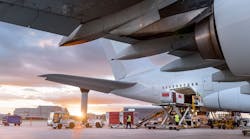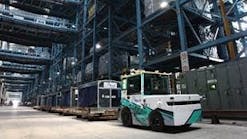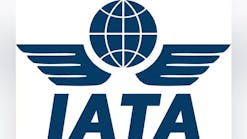To combat mishandled baggage and improve the efficiency of baggage handling, the International Air Transport Association (IATA) published Resolution 753. This resolution mandated that IATA’s airline members track baggage at four specific points during the bag’s journey.
“Resolution 753 came in effect in June 2018 and mandates that airlines should be able to track bags at four key areas – mainly check-in, loading at the aircraft, transfer and the arrival to the delivery belt,” Timos Korosis, airport system and ground product developer at Aegean Airlines, said during a recent IATA webinar titled “Ensuring Efficient Baggage Operations Through Standardization.”
“It also mandates that airlines should be able to optionally track bags at more points, if needed. But they should be able to create and store baggage tracking data and build their baggage tracking inventory and share those data with their interline partners as needed and as requested,” he added. “The end result, following a successful implementation of the Resolution 753, should be to have a visible reduction in the baggage mishandling rates for the airline, the airport or the ground handler who is following the resolution.”
However, adopting new technology and procedures can come with challenges. During the webinar, Korosis and Mohamed Arshad Khan, special airport system – senior design lead at Abu Dhabi Airport, explored the challenges faced by airlines and airports, respectively, when adopting Resolution 753 and offered recommendations for overcoming these obstacles.
The Challenges
From an airline perspective, Korosis pointed to infrastructure and staff shortages as key challenges.
“The first challenge that we stumbled upon was the infrastructure. A lot of airports are already at their capacity limit, especially as the passenger numbers rise year by year. At the same time, as airlines, we have to fly at airports with outdated baggage handling equipment or no baggage handling equipment at all,” he said.
“Then there's also the staff shortages, which were visible following the pandemic as we lost a lot of experienced staff who left the industry and moved to other sectors. This required our ground handling partners to recruit new staff – new inexperienced staff,” Korosis continued. “This led to communication issues and lack of coordination when the workload peaked.”
Korosis also noted a lack of awareness regarding the purpose of Resolution 753.
“We had key stakeholders saying that they don't know how to implement 753,” he said, adding they also questioned why they should implement the resolution and the benefits of implementation.
“The last challenges that we faced, especially following the implementation into our hub was how we could expand the project; how we could scale up in a cost-efficient manner; how we could let's say fill these holes of missing equipment and lack of staff – without driving the cost too high and also ensuring that our interline and ground handling partners can support what we want to do.”
According to Khan, challenges for airports were largely related to the cost of implementation and the investment in new equipment and training.
“Then comes the complexity of implementation. Of course, the complexity entails from the wide range of stakeholders, including the airlines, airports, ground handlers, security agencies,” he said.
Khan added that there was some resistance to adopting new procedures.
“People in the airport or the staff in the airport are mainly having a natural tendency to resist any new change. So that was one of the implementation challenges because they are used to one procedure – practices – that they keep on doing it,” he pointed out.
“The other challenge was lack of resource,” Khan continued. “When we say lack of resource, it’s mainly the financial resource, human resource, the technical expertise.”
Airports also must overcome a lack of support from external stakeholders like government agencies. What’s more, increasing the awareness of Resolution 753’s benefits was also a key element for a successful implementation.
The Solutions
To overcome challenges and successfully implement Resolution 753, Korosis recommended following four key steps.
The first recommendation is understanding all the requirements of the resolution.
“You need to ensure that you have a good knowledge of what needs to be done, how it needs to be done,” Korosis advised.
Second, he recommended mapping existing processes.
“This means that you're able to understand what's happening today at your organization,” he explained. “This step will help you understand if there are any roadblocks or any things that you have to change before you move forward with an implementation of this resolution.”
Once current processes are mapped, Korosis recommended creating an appropriate plan based on each individual organization’s strengths and weaknesses. He said it’s crucial to also consider each individual airport and that location’s ability to support technology as well as the equipment and ground handling partner at each station.
“You need to work with your partners. You need to make sure that they are engaged. You need to make them know what you want to do, what you're planning to do. And maybe they will be able to share some valuable feedback,” Korosis said.
When ensuring efficient baggage operation through standardization, Khan said the key word is collaboration.
“And the collaboration needs to be done between two parties, which is the airline and the airport,” he said.
Khan said it’s imperative that airlines and airports must provide one another with information and training to support shared goals.
“I cannot stress enough how important it is to collaborate with all stakeholders,” Korosis agreed. “It's very difficult to implement Resolution 753 unless everybody is on board.
Industry collaboration is a key element to IATA’s Baggage Working Group, where industry leaders work together on solutions.
“We can share lessons learned, best practices and what worked in our implementation, or what didn't work. This collaboration leads to process standardization while working with different people from different airlines or organizations,” he said. “This helps us adopt new technologies and make them work with existing technologies much easier than we used to do before.
“Within those groups, we are able to educate people. We are able to train people in an industry-wide level,” Korosis continued. “This also helps us implement Resolution 753 and make sure that we're at the same page and we talk the same language when it is concerning baggage tracking.”
Korosis concluded by saying the resolution is not a luxury item, as some may have thought. Rather, the results of Resolution 753 have proven to be a great asset to airline operations.
And while there are challenges to implementing the Resolution 753, Korosis said it was not as difficult as expected in the beginning stages of adoption.
“We needed to dig deep, and we spent a lot of time planning at the first steps of the implementation. But things start to accelerate much faster when you finish the first few steps. And the benefits that you get as an airline and airport or a ground handler become visible almost immediately when you start getting your hands on all that data,” he said.
“From my experience, and what I've seen, it is possible for everyone – every airline, every ground handler, every airport – no matter their size, no matter where they are located at, to create the appropriate plan and fulfill the requirements of Resolution 753.”








